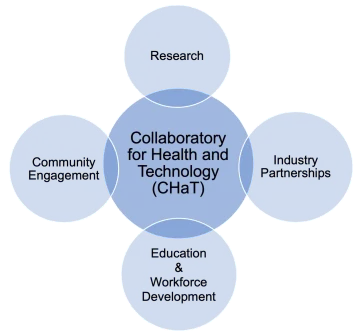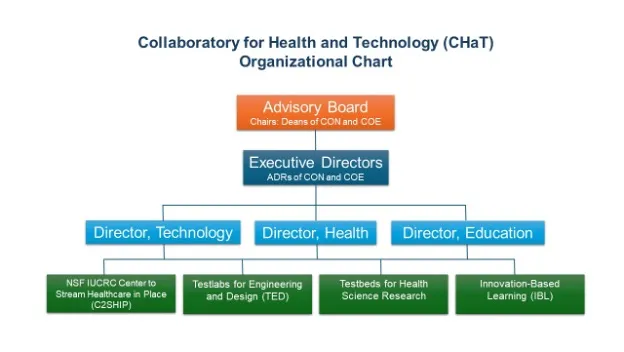The Collaboratory for Health and Technology (CHaT)
Pressing Need for Innovative Health Solutions
Healthcare challenges are becoming increasingly complex, requiring comprehensive solutions that include technology. The is a need to integrate nursing knowledge with engineering principles to design innovative solutions that enhance patient care, safety, overall healthcare outcomes. The collaboration between nursing and engineering fosters a rich exchange of ideas and expertise. Engineers bring technical skills and problem-solving methodologies, while nurses provide deep clinical insights and an understanding of patient needs. This interdisciplinary synergy leads to the development of creative and impactful solutions.
Novel solutions are needed to create an environment of learning, research, and dissemination that brings together the strengths of complementary disciplines. The demand for partnerships between nurses and engineers in healthcare is both evident and urgent. Andrews et al.1 emphasized the significance of collaboration between these two fields, stating that it expedites the creation of innovative solutions for unaddressed healthcare needs.
Furthermore, a comprehensive scoping review conducted by Zhou et al.2 highlighted the pressing need to establish interprofessional education, reinforce the ties between nursing and the healthcare engineering sector, and establish additional avenues and resources that promote the convergence of nursing and engineering disciplines to discover equitable solutions to current and future healthcare challenges. The University of Arizona is committed to enhancing healthcare and transforming how clinicians care for patients, emphasizing the need for personalized and accessible care, while stimulating education and research focused on enhancing the health and well-being of the communities we serve.
Collaboration Between the College of Nursing and College of Engineering
The Collaboratory for Health and Technology (CHaT) will create a robust, real-time partnership between the College of Nursing, the College of Engineering, and industry partners informed by the unique perspectives of nursing and engineering to identify healthcare challenges, craft and enhance solutions, evaluate outcomes, and make well-informed decisions, all aimed at enhancing healthcare. The CHaT will focus on the development, evaluation, and implementation of technology-enhanced interventions to improve the reach of evidence-based interventions.
The CHaT Mission is to:
- Harness the unique perspectives of nurses and engineers to design innovative solutions to pressing healthcare challenges.
- Develop interdisciplinary educational and research partnerships to foster creative collaborations between nurses and engineers.
- Create the next generation of healthcare leaders at the intersection of nursing and engineering.

Figure 1. CHaT Mission
CHaT Goals
- Development and Learning – Bringing nursing and engineering faculty and students together to explore the combination of evidence-based interventions and digital technologies, machine learning (ML)/artificial intelligence (AI), and big data to improve the provision of healthcare.
- Research – Facilitating nursing and engineering partnerships to apply technology to solve real-world health problems through pilot funding and mentored research experiences.
- Workforce Development – Undergraduate and graduate dual degree programs and a postdoctoral fellowship program will prepare students and fellows to conduct research and lead healthcare transformation.
- Dissemination – Engaging with communities and partnering with industry to identify healthcare needs and disseminate scalable, accessible solutions.
Infrastructure
The Collaboratory for Health and Technology building will use its state-of-the-art facilities for teaching, learning, and research. The existing test beds, sensor lab, offices, shared meeting spaces, and research areas in the UAHS, College of Nursing, and College of Engineering will facilitate creative collaborations between nursing and engineering faculty, students, and staff.
The test beds and sensor lab will provide space for testing technology-enhanced interventions in healthcare and home settings. These spaces enable innovative research and development in microsensors, microdevices, ML/AI, and big data solutions to healthcare challenges. These spaces are able to simulate inpatient hospital, long-term care, assisted living, and home environments, and will be equipped with wearables, sensors, electronic test equipment, 3D printers, and more.
Offices, research space, conference room space and other core scientific and educational facilities are available through the University of Arizona Health Sciences, College of Nursing, and College of Engineering to facilitate collaboration.
Administrative Structure
The CHaT will be led by the College of Nursing in partnership with the College of Engineering. The ChaT will be led by two co-Executive Directors reporting directly to the Deans of the Colleges of Nursing and Engineering. There will be Directors from both colleges reporting to the Executive Directors. In addition, we have established a CHaT Advisory Committee. The CHaT Advisory Committee unites distinguished leaders across the University with expertise in digital health, ML/AI, big data, digital health laboratories, participant engagement, nursing, psychology, and engineering. By creating a transdisciplinary team, we ensure that our solutions will have real-world impact and improve the health of Arizonans and beyond.

Figure 2. CHaT Organizational Structure
Leveraging Existing Resources
The CHaT will leverage robust existing resources at the University of Arizona, including:
- College of Nursing faculty and students, core labs, and individual faculty labs
- Engineering faculty and students, core labs and test beds, individual faculty labs, and the
- Digital Health Hub
- The BIO5 Institute
- The Center for Biomedical Informatics and Biostatistics (CB2)
- Tech Launch Arizona
References
- Andrews R, et al. Collaboration for clinical innovation: a nursing and engineering alliance for better patient care. J Res Nurs 2020;25(3):291–304.
- Zhou Y, et al. Interdisciplinary collaboration between nursing and engineering in health care: a scoping review. Int J Nurs Stud 2021;117:103900.

